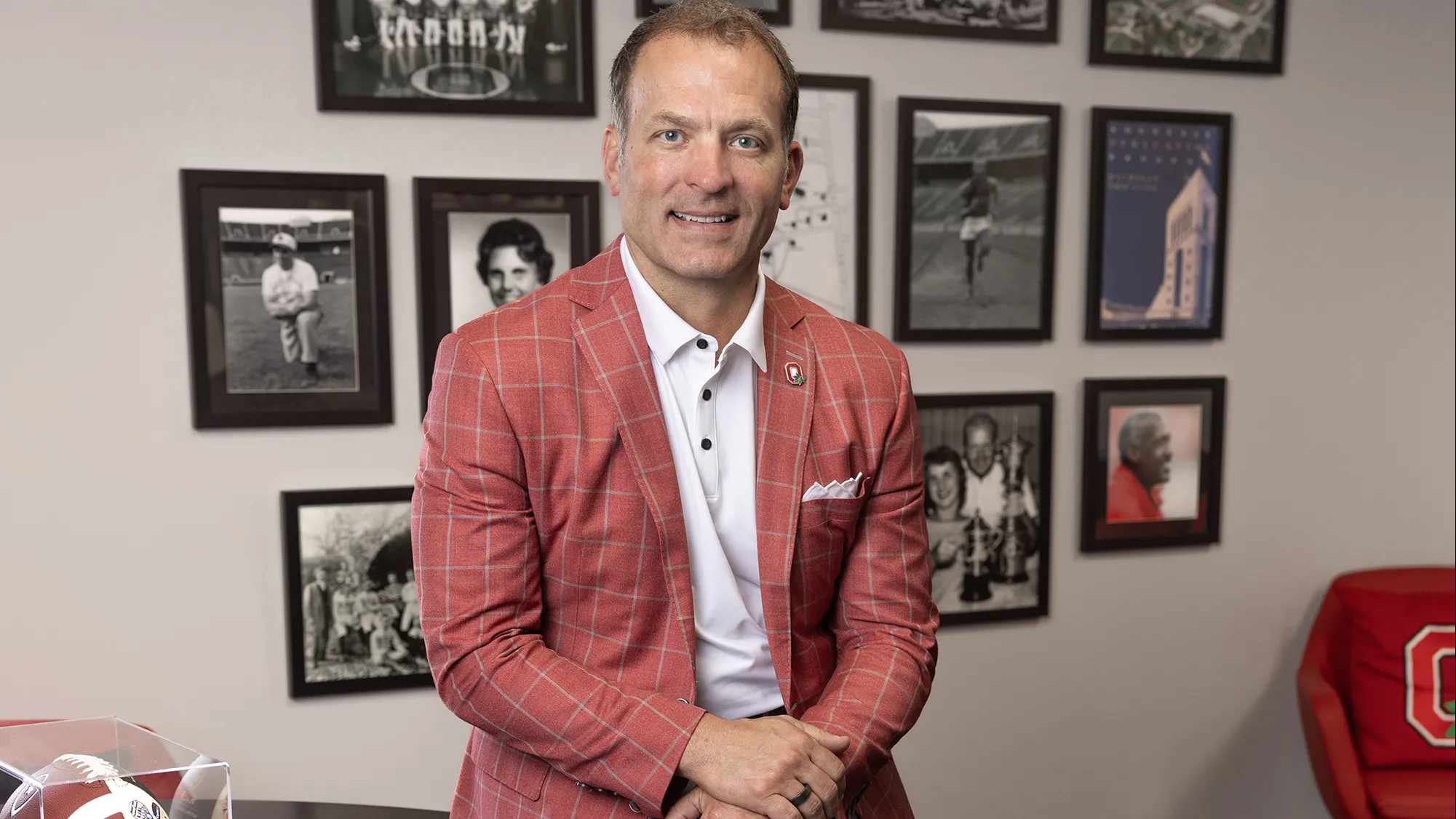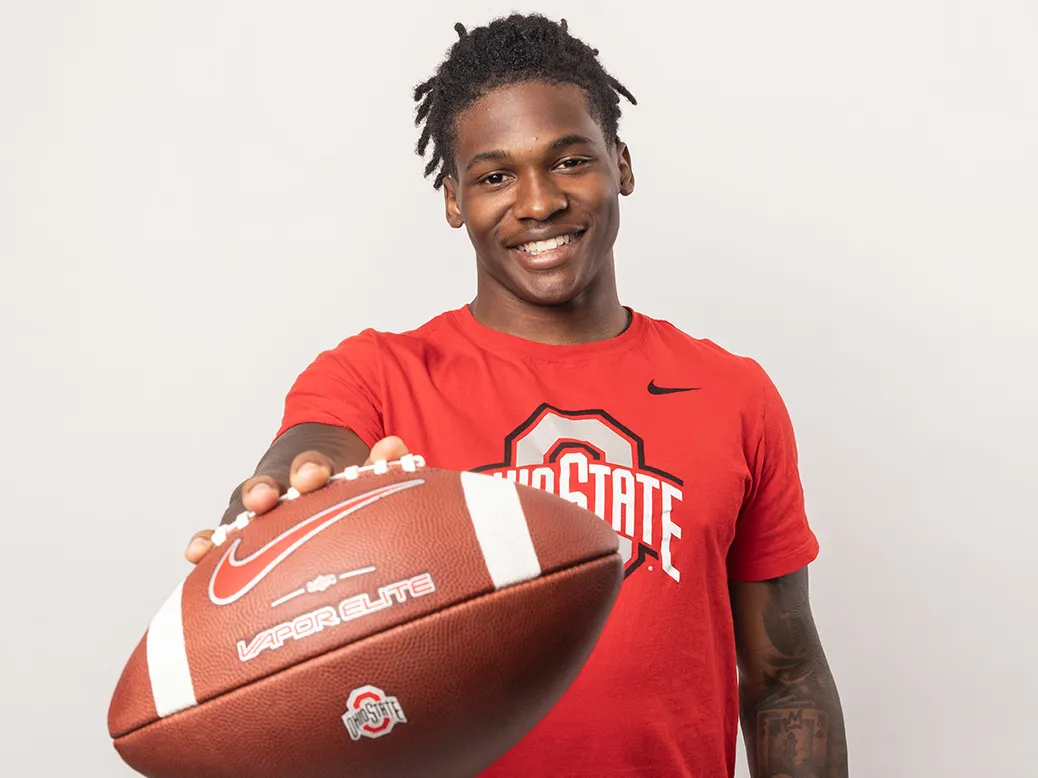
Let Ross Bjork guide you in this wild world of sports
Constantly changing NCAA rules, often dictated by court decisions, have caused upheaval in the traditions and normalcy of college athletics while creating a steady stream of questions for fans. How will the Buckeyes be impacted by all this in terms of roster sizes and numbers of available scholarships? What’s the future of Name, Image and Likeness (NIL) payments for student-athletes? Anything new with the transfer portal?
Ross Bjork, one year into his tenure as Ohio State’s senior vice president and Wolfe Foundation-Eugene Smith Endowed Athletics Director, recently took questions from alumni about the choppy sea of college sports. Read on for answers and find more in the video, run time 3 minutes, 37 seconds.
How do you feel about NIL and the transfer portal? — Mary Durkin ’67
I believe that athletes should be able to capitalize on their Name, Image and Likeness. But now we’ve gone to a new model where we’re sharing revenue, and perhaps if (the NCAA) had made the right changes along the way, then we wouldn’t have gotten to these extreme positions.
My transfer portal viewpoint: I think if you have the right culture, if you communicate with your athletes, and somebody still wants to leave because they want to play more or maybe it’s not the right fit, we should not restrict athletes from moving. What we’re not seeing in this conversation is what’s best academically for student-athletes. That’s my main concern around the transfer portal.
How do you envision Ohio State setting the gold standard for navigating the challenges posed by NIL? — Patrick Stephan ’73
People may not like what’s going on in college athletics. It may feel different. We might all feel uncomfortable in many ways. But if we stay organized, if we inform ourselves, if we communicate, people are always going to look to Ohio State. We have 36 sports, the most of any major program in the country. We have the biggest brand in college athletics. We sell the most merchandise. We have the biggest sponsorship revenue category. We generate a lot of resources here. The gold standard is going to be set by keeping the fundamentals the fundamentals: academics and maintaining 36 sports.
Do you foresee Ohio State discontinuing any of the women’s teams? — Barb Nicholas ’77
The answer to that is unequivocally no. We are committed to 36 sports. We believe we’re in great shape for the next five to seven years. As things continue to evolve, we want to make sure we adapt and innovate around that. But we need to maintain the history and legacy of those 36 sports. We need to provide as many opportunities for our young people as possible. That’s going to be our charge moving forward.
What incentives are the athletic department offering to athletes, particularly in football and basketball, to prevent them from entering the transfer portal? — Stu Chapman ’77
If an athlete receives what’s called institutional payments—revenue sharing—there will be a memo of understanding between the athlete and the institution that will have parameters around if they want to transfer. They could maybe pay some money back. They could have sort of liquidated damages. It’s not an employment contract, but it’s a memo of understanding. That is one way. But I think it really goes back to the culture of your programs. If everything is clicking at the highest level, most of the time you can weather any situation around an athlete chasing maybe a better financial agreement or something.
How do Ohio State athletes in Olympic sports share in the new revenue sharing? — Robert Hensley ’74
That’s a work in progress. As we start this endeavor, we will have four sports that receive the institutional NIL revenue share: football, men’s and women’s basketball, and our women’s volleyball program. Over time, as that revenue share number increases—it increases 4 percent annually, starting at $20.5 million—we hope to add more sports to that category. That’s going to be a goal.
Are athletes now allowed to have an agent? — Nick Captor ’81
Yes. That really came about with the advent of Name, Image and Likeness back in 2020-2021. Athletes started having marketing agents. We’re seeing agents even more prevalent now that the dollars are really getting to a level where the athletes need to protect themselves. We encourage athletes to have representation. They need to be educated on the issues. We think representation is key for them to really safeguard against what the pitfalls might be out there.
In addition to NIL issues, what’s the biggest concern next for college athletics? — Robert Golaszewski ’79
We’ve been in the courtroom for the last 10 years, fighting all these legal battles. We need a legally defensible model that is sustainable for long-term success so that your kids, your grandkids have a model where they say: “That’s sports and that’s education.” At the end of the day, those two things are not going to go away: the education part and the playing part. But everything in between looks different.

